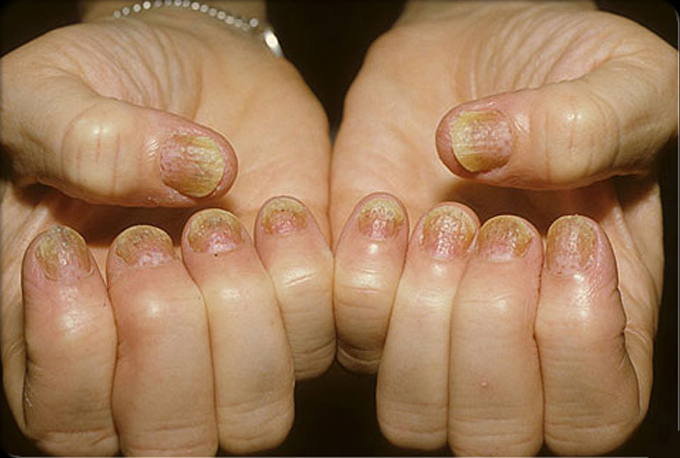If you have psoriasis and notice some changes in your nails, there are many treatments you can use to improve this condition of your nails and skin.

Nail psoriasis can alter the appearance of fingernails and toenails. They can get thick and change color or shape. They may also feel sensitive and hurt.
Table of Contents
Symptoms of Psoriasis on the nails
You can tell that you are suffering from nail psoriasis when you see these changes in your hands and feet:
- Nails can turn green, yellow, or brown. They may also have small red or white spots underneath.
- Superficial appearance. The nails may have grooves, small deformations or pitting that will be present on the nail surface.
- Accumulation of waste. A chalky white material can collect under the nails, causing it to lift off the skin. And this can be very painful.
- Thickening of the nails. About a third of people with nail psoriasis can also have a fungal infection that can cause the nails to thicken. It can also become brittle and break.
- Separation. The nail can loosen or lift.
Some of these changes in the hands can make it difficult to move the fingers and toes. It can also cause a lot of pain in the nails. Which can make certain tasks with the hands difficult.
How to prevent nail problems
Hand care is the best way to treat nail psoriasis. For this you can try the following tips:
- Keep your nails short.
- Use a nail file to keep the edges smooth.
- Wear gloves to clean and do other hand jobs.
- You should hydrate your nails and cuticles every day, especially after they have been in contact with water.
- Wear comfortable shoes with plenty of room for your toes.
You can protect your nails from further damage by using some of the tips below. Some people are sensitive to chemicals like nail polish and glue, so you need to try to avoid use, especially in the healing stage.
Treatments for nail psoriasis
The same treatments that you use for psoriasis of the skin can also treat psoriasis of the nail. Because nails grow slowly, it may take time before you see any improvement in the newly grown pieces of the nail.
1. Soak your nails
Add oil, colloidal oatmeal (finely ground oatmeal), Epsom salts, or sea salt to a hot bath to help remove dry patches of skin and relieve itching and burning. But you need to be careful: hot water can further aggravate the skin condition. It’s best to soak in the tub for 15 minutes and then apply a moisturizer or oil to your skin as soon as you finish your bath, recommends the National Psoriasis Foundation.
2. Use a moisturizer
Psoriasis causes dry skin and can cause itching and burning, which can make the skin condition worse. To avoid these aggravating skin symptoms, it is important to always keep your skin hydrated by applying a moisturizer all over your body.
3. Use cayenne
According to Discovery Health, capsaicin, which is the substance that gives cayenne pepper its heat, can help relieve pain and itching by blocking the communication system of sensitive nerves.
Capsaicin has been shown to not only soothe the skin but also to get rid of the nail condition. Look for a cream that contains capsacin, or you can add ground cayenne pepper, in a small fraction, to your moisturizer. It will take about a week for the cream to start working, and it is best to keep your hands away from your eyes and nose to avoid a burning sensation. This is an alternative way to treat nail psoriasis.
4. Use apple cider vinegar
The vinegar cider is commonly used to treat burns and skin inflammation minor , and is also used as a disinfectant. The National Psoriasis Foundation indicates that patients can use a vinegar bath to treat their skin and nail condition. If your fingernails and toenails get infected, you can pour some vinegar into a container and soak your nails for a few minutes. Also, patients can moisten cotton swabs with vinegar and then apply it to the affected areas of the skin.
5. Wrap the area
Gently wrap the skin after applying a topical ointment or natural cream that you can make at home specially to treat psoriasis and eczema. This is an effective way to cover your sores and leave the moisturizer to absorb into the skin. For greater benefit you can wrap the area with a tape or bandage but without direct adhesives to the skin.
